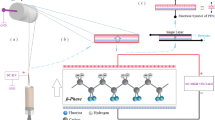Abstract
Technological advances have profoundly influenced the design of wearable and flexible electromechanical sensors in piezoelectric materials technology. This article investigates the enhancement of the piezoelectric performance of polyvinylidene difluoride (PVDF) with the addition of nanosilica (SiO2). The use of nanoparticles can overcome the difficulties associated with PVDF, and the touch sensor was fabricated using a sandwich-based assembly. A comparison of the piezo potential generated across the fabricated sensor samples with and without nanofiller was conducted. The experimental results demonstrate that the nanosilica addition improves the piezo-response of the touch sensor and thus has a promising application in the biomedical field.






Similar content being viewed by others
References
Hari MA, Rajan L. Advanced materials and technologies for touch sensing in prosthetic limbs. IEEE Trans NanoBiosci. 2021. https://doi.org/10.1109/TNB.2021.3072954.
Ueberschlag P. Pvdf piezoelectric polymer. Sens Rev. 2001. https://doi.org/10.1108/02602280110388315.
Kalimuldina G, Turdakyn N, Abay I, Medeubayev A, Nurpeissova A, Adair D, Bakenov Z. A review of piezoelectric pvdf film by electrospinning and its applications. Sensors. 2020;20(18):5214.
Toda M, Thompson ML. Contact-type vibration sensors using curved clamped pvdf film. IEEE Sens J. 2006;6(5):1170–7.
AlMohimeed I, Agarwal M, Ono Y, “Wearable ultrasonic sensor using double-layer pvdf films for monitoring tissue motion,” in 2018 IEEE Canadian Conference on Electrical & Computer Engineering (CCECE). IEEE. 2018. pp. 1–4.
Shin D-M, Hong SW, Hwang Y-H. Recent advances in organic piezoelectric biomaterials for energy and biomedical applications. Nanomaterials. 2020;10(1):123.
Tanaka M, Tanaka Y, Chonan S. Measurement and evaluation of tactile sensations using a pvdf sensor. J Intell Mater Syst Struct. 2008;19(1):35–42.
Bodkhe S, Rajesh P, Kamle S, Verma V. Beta-phase enhancement in polyvinylidene fluoride through filler addition: comparing cellulose with carbon nanotubes and clay. J Polym Res. 2014;21(5):1–11.
Hari MA, Rajan L, Subash C, Varghese S. “Effect of nanoparticle size on the piezoelectric properties of pvdf based nanocomposite thin films.” Materials Today: Proceedings. 2021.
Ferreira J, Monteiro T, Lopes A, Costa C, Silva MM, Machado A, Lanceros-Mendez S. Variation of the physicochemical and morphological characteristics of solvent casted poly (vinylidene fluoride) along its binary phase diagram with dimethylformamide. J Non-Cryst Solids. 2015;412:16–23.
Shirinov AV, Schomburg WK. Pressure sensor from a pvdf film. Sens Actuators, A. 2008;142(1):48–55.
Hari MA, Karumuthil SC, Varghese S, Rajan L. Performance enhancement of flexible and self-powered pvdf-zno based tactile sensors. IEEE Sens J. 2022. https://doi.org/10.1109/JSEN.2022.3166706.
Chen Y, Feng R, Li Y, Dan N, Yang C, Yu G, Huang Y, Wen H, Dan W. Development and analysis of a novel pvdf membrane with higher content of β phase. Int J Polym Anal Charact. 2019;24(8):684–95.
Yangzhou Z, Weifeng Y, Chaoyang Z, Bin G, Ning H. Piezoelectricity of nano-sio2/pvdf composite film. Mater Res Expr. 2018;5(10): 105506.
Haddadi SA, Ramazani A, Talebi SAS, Fattahpour S, Hasany M. Investigation of the effect of nanosilica on rheological, thermal, mechanical, structural, and piezoelectric properties of poly (vinylidene fluoride) nanofibers fabricated using an electrospinning technique. Ind Eng Chem Res. 2017;56(44):12596–607.
Funding
The authors received no financial support for the research, authorship, and/or publication of this article.
Author information
Authors and Affiliations
Corresponding author
Ethics declarations
Conflict of Interest
The authors declare that they have no conflict of interest.
Additional information
Publisher's Note
Springer Nature remains neutral with regard to jurisdictional claims in published maps and institutional affiliations.
This article is part of the topical collection “Smart and Connected Electronic Systems“ guest edited by Amlan Ganguly, Selcuk Kose, Amit M. Joshi and Vineet Sahula.
Rights and permissions
Springer Nature or its licensor (e.g. a society or other partner) holds exclusive rights to this article under a publishing agreement with the author(s) or other rightsholder(s); author self-archiving of the accepted manuscript version of this article is solely governed by the terms of such publishing agreement and applicable law.
About this article
Cite this article
Hari, M.A., Divya, R.S., Rakesh, K. et al. Flexible and Self-Powered PVDF-Nanosilica Based Piezoelectric Touch Sensor. SN COMPUT. SCI. 4, 64 (2023). https://doi.org/10.1007/s42979-022-01477-3
Received:
Accepted:
Published:
DOI: https://doi.org/10.1007/s42979-022-01477-3




